Study on the Characteristics of Trackside Acoustic Flow Field of High-Speed Train under the Influence of Crosswind
Abstract
:1. Introduction
2. Calculation Model for High-Speed Trains
2.1. Train Model Simplification
- (1)
- Reduce the number of train compartments and the length-to-slender ratio of the train. This paper adopts the whole train calculation model of three formations, i.e., head car, middle car and tail car, in which the head car and tail car are identical in shape, the length is 27 m, the length of the middle car is 25 m, the width of the car is 3.36 m, and the height of the car is 4.05 m.
- (2)
- Simplify the design of the car body shape. Ignore complex devices such as the pantograph above the roof, the structure connecting the carriages, the windows and the doors, and build a smooth body model to reduce the computational complexity.
- (3)
- Simplify the bogie of the car body. The bogie consists of five parts: frame, travel system, suspension system, braking system, and traction device. According to the focus of this study, only the bogie bearings, frame and wheel structure need to be retained; the bogie wheelbase is 2.5 m, and the wheel diameter is 0.95 m.
2.2. Selection of the Flow Field Region
2.3. Model Meshing
2.4. Acoustic Flow Field Simulation Process
2.5. Sound Source Location and Field Point Grid Definition
- (1)
- Surface vibration sound source. Since the high-speed train trackside sound field is aimed at the sound waves from bearing faults, and the sound from bearing faults is finally propagated to the outside world through the bearing cover, the surface vibration sound source is placed at the axle box cover position, which can more accurately simulate the propagation of sound waves when bearing faults are generated. The placement of the sound source in this paper is shown in Figure 5.
- (2)
- Field point size. The field point grid is too large to affect the calculation time and calculation accuracy, so it should be set appropriately. The size and location of the field point grid used in this paper are shown as the yellow grid in Figure 6.
3. High-Speed Train Trackside Sound Field Distribution Map Analysis
3.1. Mathematical Calculation Modeling under the Joint Influence of Vehicle Speed, Wind Direction Angle and Sidewind Speed
3.2. Analysis of the Effect of Different Vehicle Speeds on the Sound Field Calculation
3.3. Analysis of the Effect of Different Wind Angles on the Calculation of the Sound Field
3.4. Analysis of the Effect of Different Side Wind Speeds on the Sound Field Calculation
4. High-Speed Train Trackside Sound Pressure Frequency Response Graph Analysis
4.1. Influence of Vehicle Speed
4.2. Influence of Wind Direction Angle
4.3. Influence of Side Wind Speed
5. Conclusions
- (1)
- Sidewinds can have an effect on the sound field distribution at the trackside. When a sidewind exists, the fluid velocity on the train surface increases at the same speed, and the train surface is enhanced by the gas flow.
- (2)
- At different vehicle speeds, the acoustic pressure value at the same location increases gradually with the increase in vehicle speed in the frequency range of 10 Hz to 70 Hz. And when the vehicle speed is 120 km/h, the degree of change in the acoustic signal is not obvious, so it is easier to detect and capture if a bearing failure occurs.
- (3)
- Under different wind angles, as the wind angle increases, the sound pressure value at the same position of the trackside sound field gradually becomes smaller and lower than that of the non-sidewind situation. When the frequency range is between 10 Hz~150 Hz, the smaller the wind angle, the more favorable for location of the fault sound source.
- (4)
- At different sidewind speeds, the sound pressure value and distribution area of the train trackside sound field are the largest when the sidewind speed is 10 m/s (force 5 wind), which is very favorable for the reception and diagnosis of acoustic signals.
Author Contributions
Funding
Data Availability Statement
Acknowledgments
Conflicts of Interest
References
- Zhang, S. Research on Time-Varying Array Analysis of Fault Spectrum Identification in Trackside Acoustic Diagnosis of Train Bearing; University of Science and Technology of China: Hefei, China, 2017. [Google Scholar]
- Wei, X. Research on Spatio-Temporal Filter Design Methods of Multiple Sources Aliasing in Wayside Acoustic Fault Diagnosis of Train Bearing; University of Science and Technology of China: Hefei, China, 2019. [Google Scholar]
- Han, J.; Cui, L.; Li, X.; Song, C.; Zhan, L. Diagnosis and study on abnormal noise of EMUs bearing. Electr. Drive Locomot. 2020, 272, 149–153. [Google Scholar]
- Bunn, F.; Zannin, P.H.T. Assessment of railway noise in an urban setting. Appl. Acoust. 2016, 104, 16–23. [Google Scholar] [CrossRef]
- Licitra, G.; Fredianelli, L.; Petri, D.; Vigotti, M.A. Annoyance evaluation due to overall railway noise and vibration in Pisa urban areas. Sci. Total Environ. 2016, 568, 1315–1325. [Google Scholar] [CrossRef] [PubMed]
- Gidlöf-Gunnarsson, A.; Ögren, M.; Jerson, T.; Öhrström, E. Railway noise annoyance and the importance of number of trains, ground vibration, and building situational factors. Noise Health 2012, 14, 190. [Google Scholar] [CrossRef] [PubMed]
- Petri, D.; Licitra, G.; Vigotti, M.A.; Fredianelli, L. Effects of exposure to road, railway, airport and recreational noise on blood pressure and hypertension. Int. J. Environ. Res. Public Health 2021, 18, 9145. [Google Scholar] [CrossRef] [PubMed]
- Sørensen, M.; Hvidberg, M.; Hoffmann, B.; Andersen, Z.J.; Nordsborg, R.B.; Lillelund, K.G.; Jakobsen, J.; Tjønneland, A.; Overvad, K.; Raaschou-Nielsen, O. Exposure to road traffic and railway noise and associations with blood pressure and self-reported hypertension: A cohort study. Environ. Health 2011, 10, 92. [Google Scholar] [CrossRef] [PubMed]
- Liu, F.; Zhao, X.; Zhu, Z.; Zhai, Z.; Liu, Y. Dual-microphone active noise cancellation paved with Doppler assimilation for TADS. Mech. Syst. Signal Process. 2023, 184, 109727. [Google Scholar] [CrossRef]
- Li, Y.; Yi, H.; Wang, H.; Ding, X.; Xiao, J.; Pan, H.; Shao, Y. Parameterized Doppler Adaptive Correction for Wayside Acoustic Array Signal. In Proceedings of TEPEN 2022: Efficiency and Performance Engineering Network; Springer Nature: Cham, Switzerland, 2023; pp. 318–329. [Google Scholar]
- Li, J.; Chen, E.; Liu, Y. Feature extraction method of sound singal to rolling bearing based on blind source separation and morlet wavelet. J. Mech. Strength 2018, 40, 528–533. [Google Scholar]
- Ren, Z.S.; Xu, Y.G.; Wang, L.L.; Qiu, Y.Z. Study on the running safety of high-speed trains under strong cross winds. J. China Railw. Soc. 2006, 6, 46–50. [Google Scholar]
- Wang, X. Study on Aerodynamic Characteristics of High Speed Trains under Crosswind; Southwest Jiaotong University: Chengdu, China, 2019. [Google Scholar]
- Xie, H. Influence of strong crosswind on aerodynamic performance of high speed train at the speed of 350 km/h. J. East China Jiaotong Univ. 2019, 36, 7–15. [Google Scholar]
- Hao, N. Research on wind tunnel test technology for high-speed train aerodynamic noise. In Proceedings of the 2016 National Academic Conference on Aerodynamic Acoustics, Beijing, China, 4 November 2016; pp. 9–17. [Google Scholar]
- Xiao, Y.; Kang, Z. Numerical prediction of aerodynamic noise radiated from high speed train head surface. J. Cent. South Univ. Sci. Technol. 2008, 39, 1267–1272. [Google Scholar]
- Chen, W.; Wu, S. Numerical analysis of aerodynamic noise of a new high-speed train. Appl. Mech. Mater. 2013, 275–277, 681–686. [Google Scholar] [CrossRef]
- Liu, Y.; Liu, Z.; Yao, S. Comparison of unsteady and steady simulations of the flow around trains. J. Beijing Jiaotong Univ. 2014, 38, 32–39. [Google Scholar]
- Liang, X.-F.; Liu, H.-F.; Dong, T.-Y.; Yang, Z.-G.; Tan, X.-M. Aerodynamic noise characteristics of high-speed train foremost bogie section. J. Cent. South Univ. 2020, 27, 1802–1813. [Google Scholar] [CrossRef]
- Zhu, J.; Lei, Z.; Li, L. Flow-induced noise behaviour around high-speed train wheelsets. J. Mech. Eng. 2019, 55, 69–79. [Google Scholar]
- Kim, H.; Hu, Z.; Thompson, D. Effect of cavity flow control on high-speed train pantograph and roof aerodynamic noise. Railw. Eng. Sci. 2020, 28, 54–74. [Google Scholar] [CrossRef]
- He, J.; Li, Y.; Tan, X.; Yang, Z.; Liu, J. Investigation on aeroacoustic performance of EMU6. J. Railw. Sci. Eng. 2018, 15, 1911–1919. [Google Scholar]
- Zhang, Y.; Zhang, J.; Li, T. Contribution analysis of aerodynamic noise of high-speed train. J. Traffic Transp. Eng. 2017, 17, 78–88. [Google Scholar]
- Zhao, J.; Yang, S.; Li, Q.; Liu, Y. A New Transfer Learning Method with Residual Attention and Its Applications on Rolling Bearing Fault Diagnosis. China Mech. Eng. 2023, 34, 332. [Google Scholar]
- Zhang, J.; Guo, T.; Sun, B.; Zhou, S.; Zhao, W. Research on the characteristics of aerodynamic noise source for high-speed train. J. China Railw. Soc. 2015, 37, 10–18. [Google Scholar]
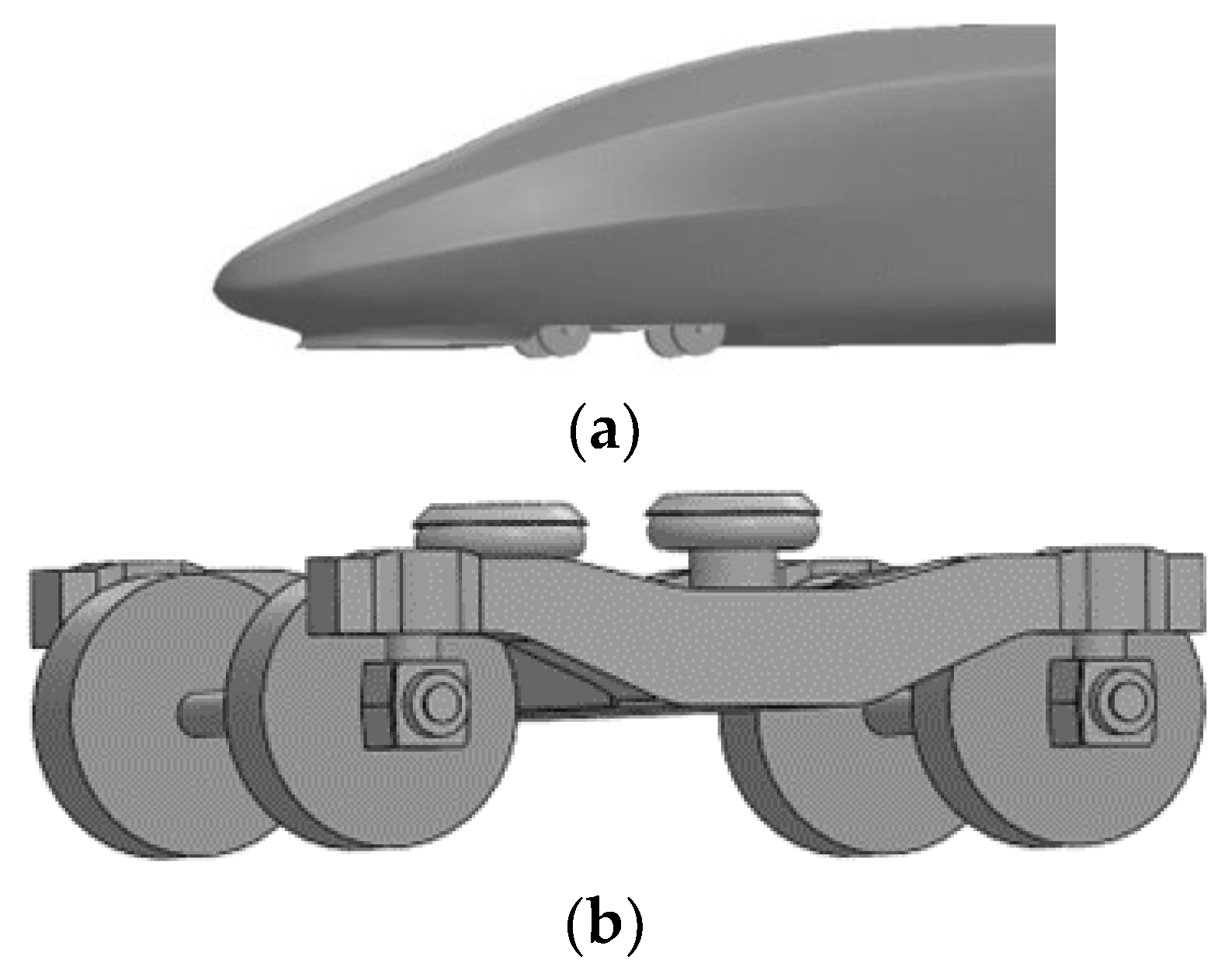


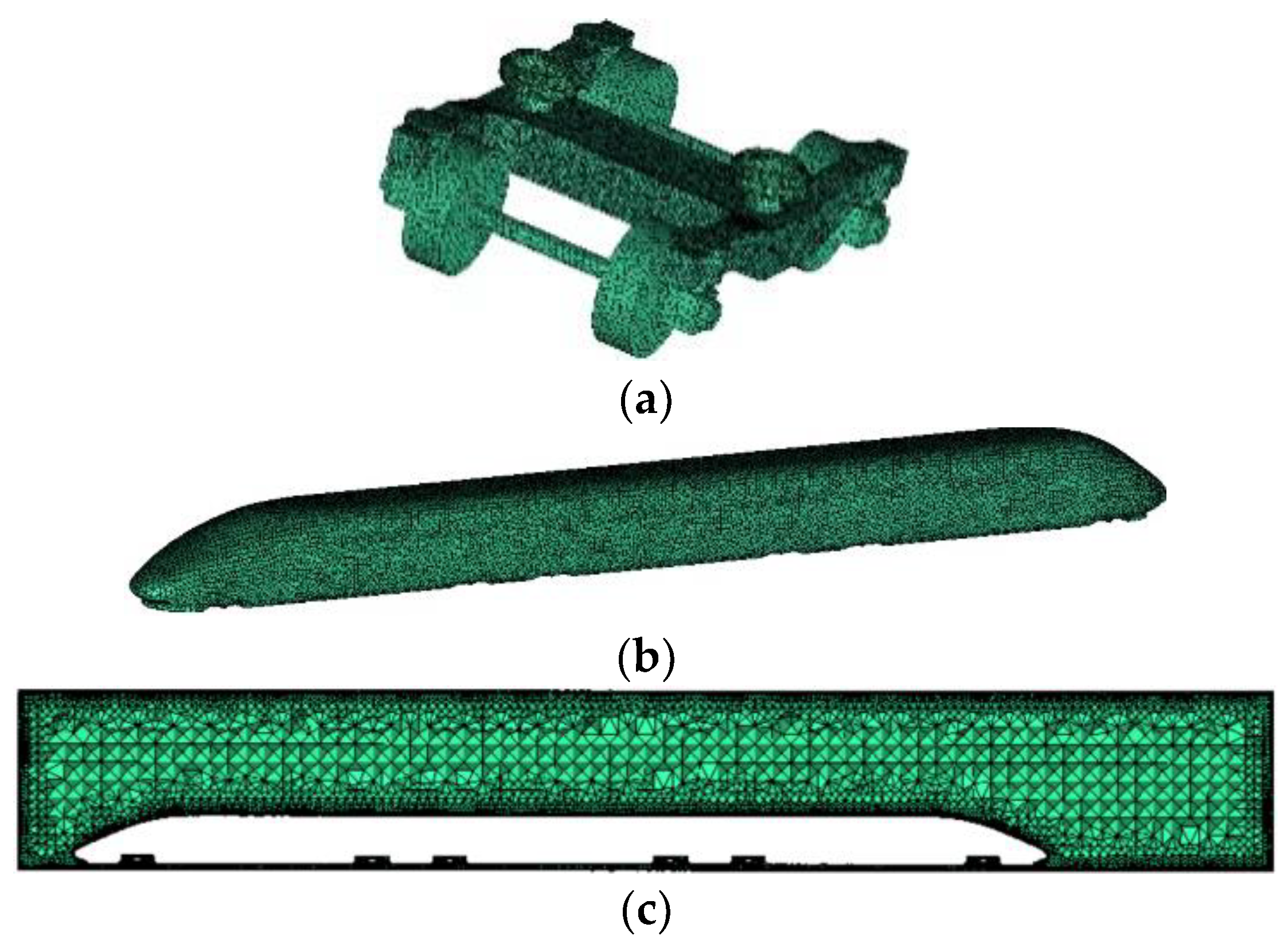

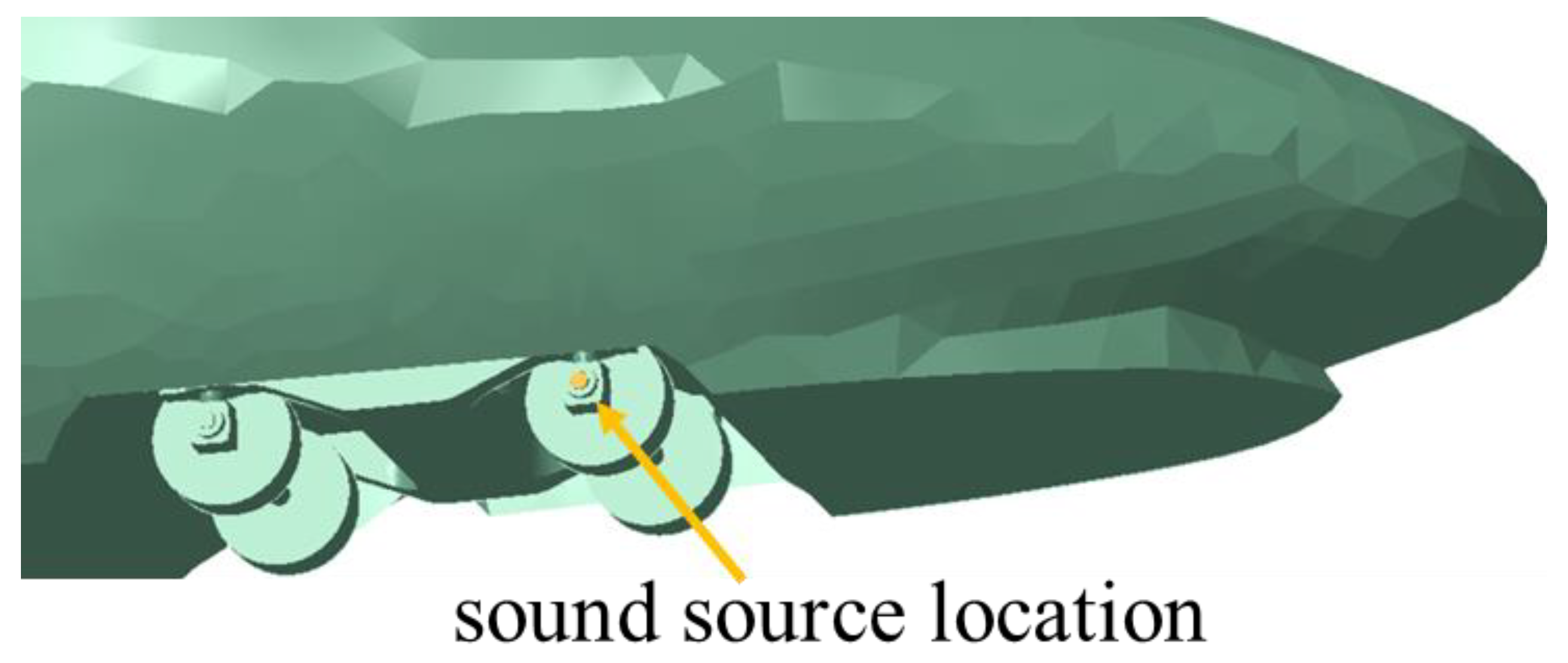



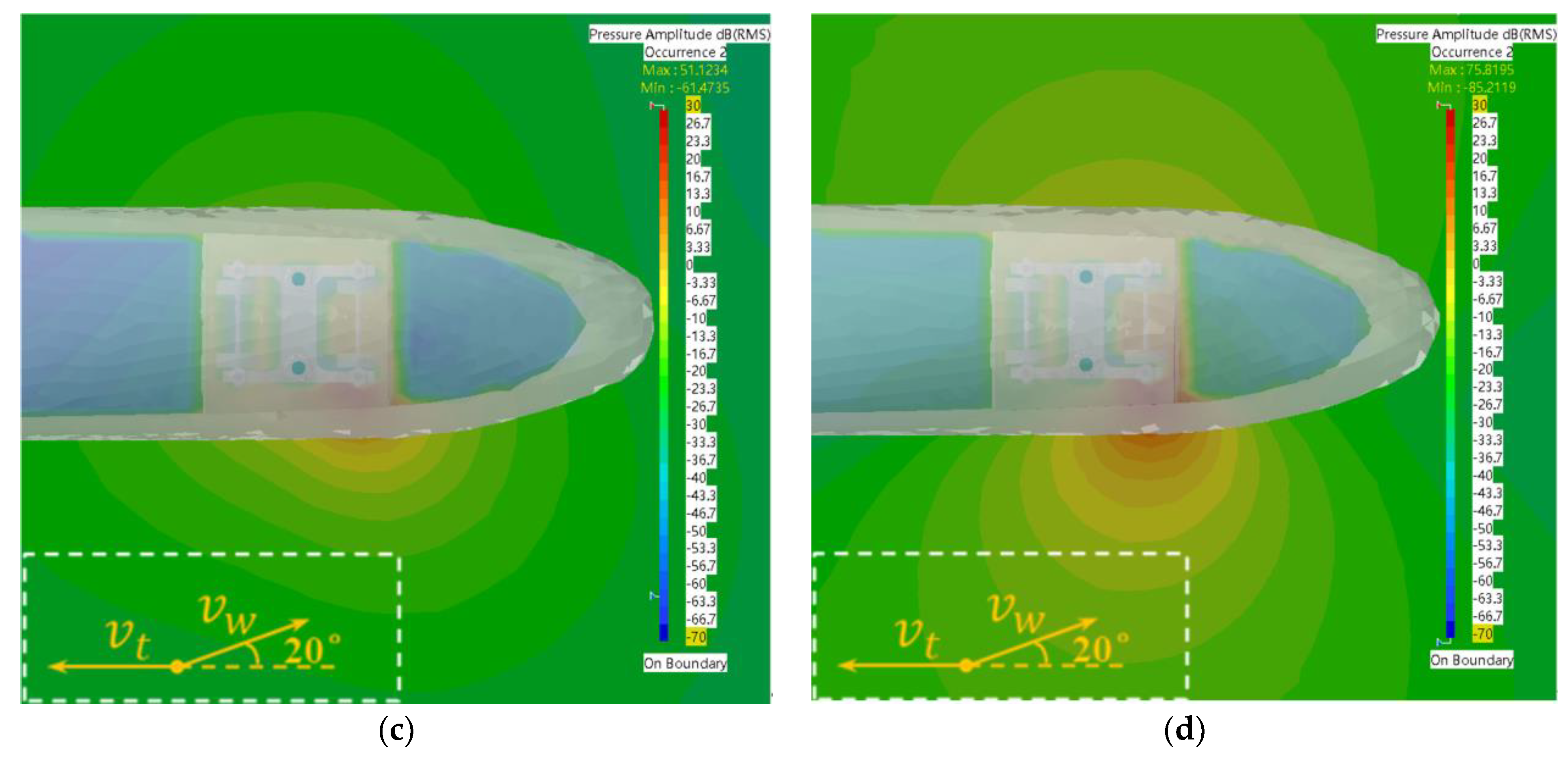
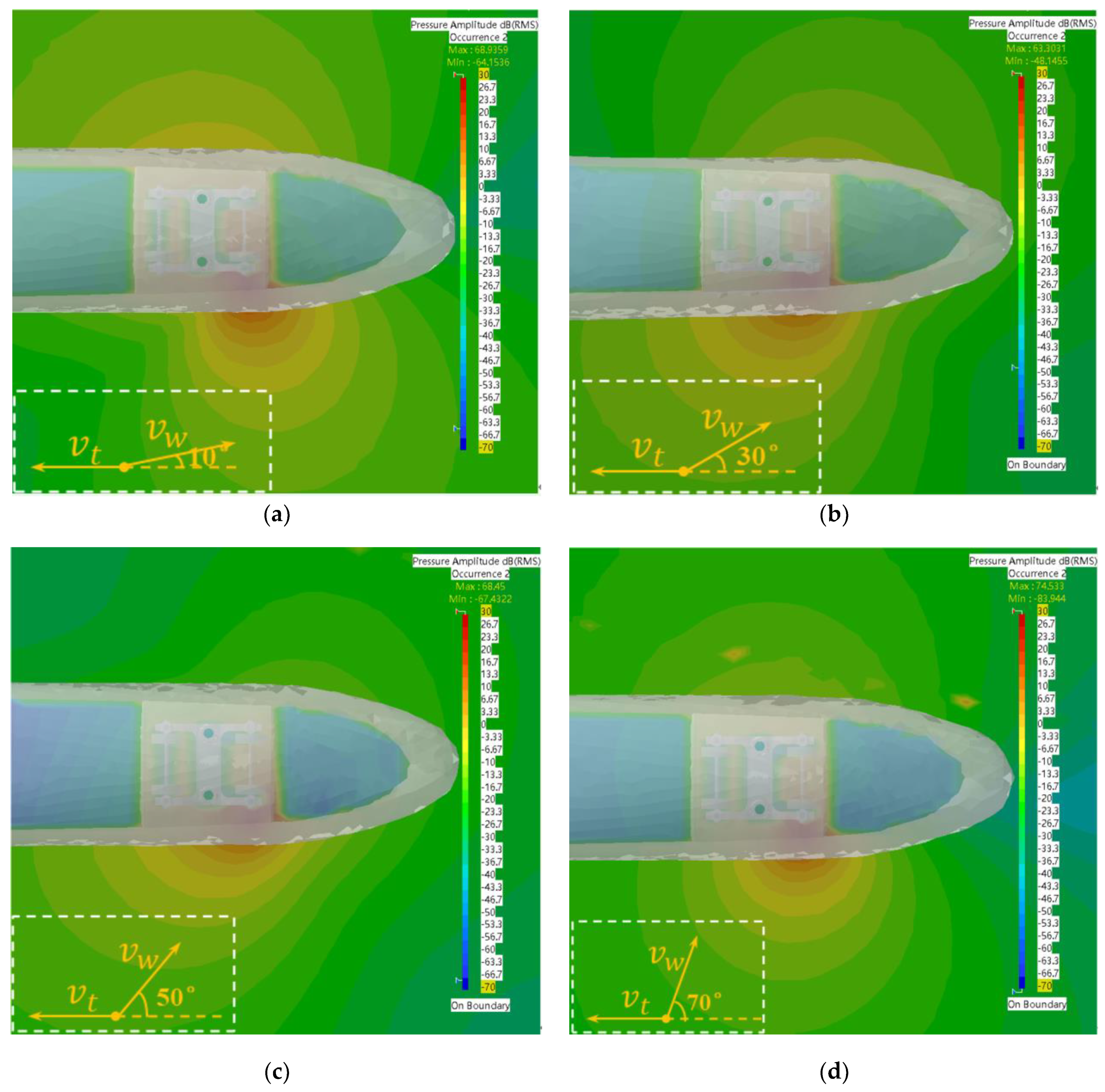
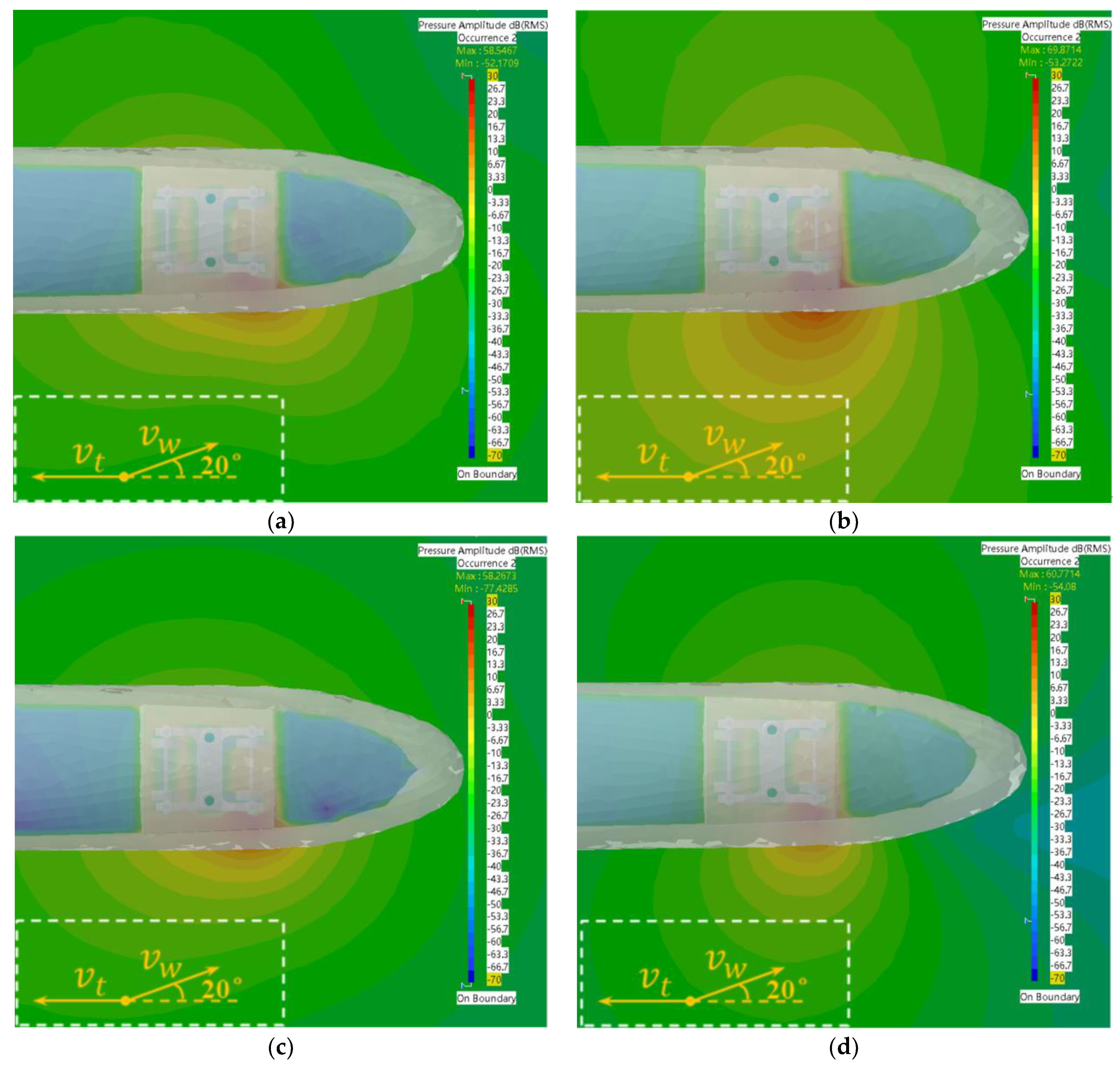

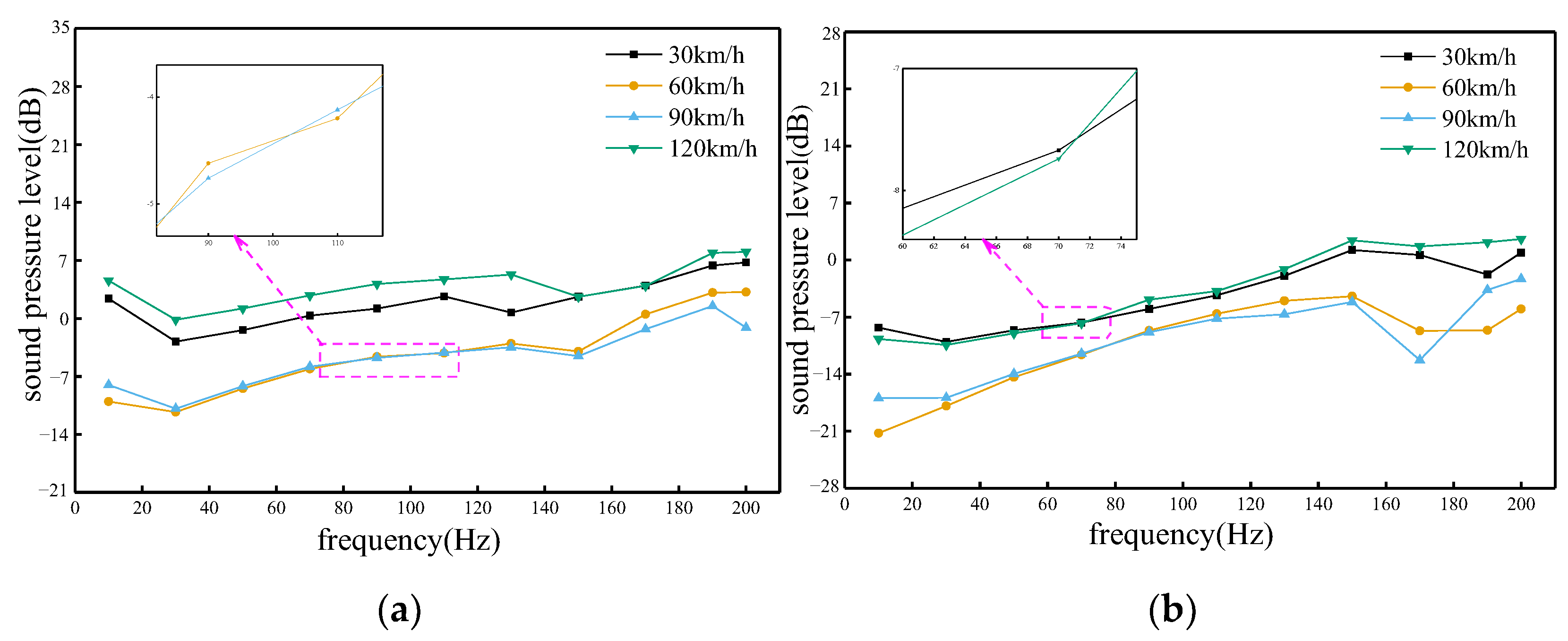

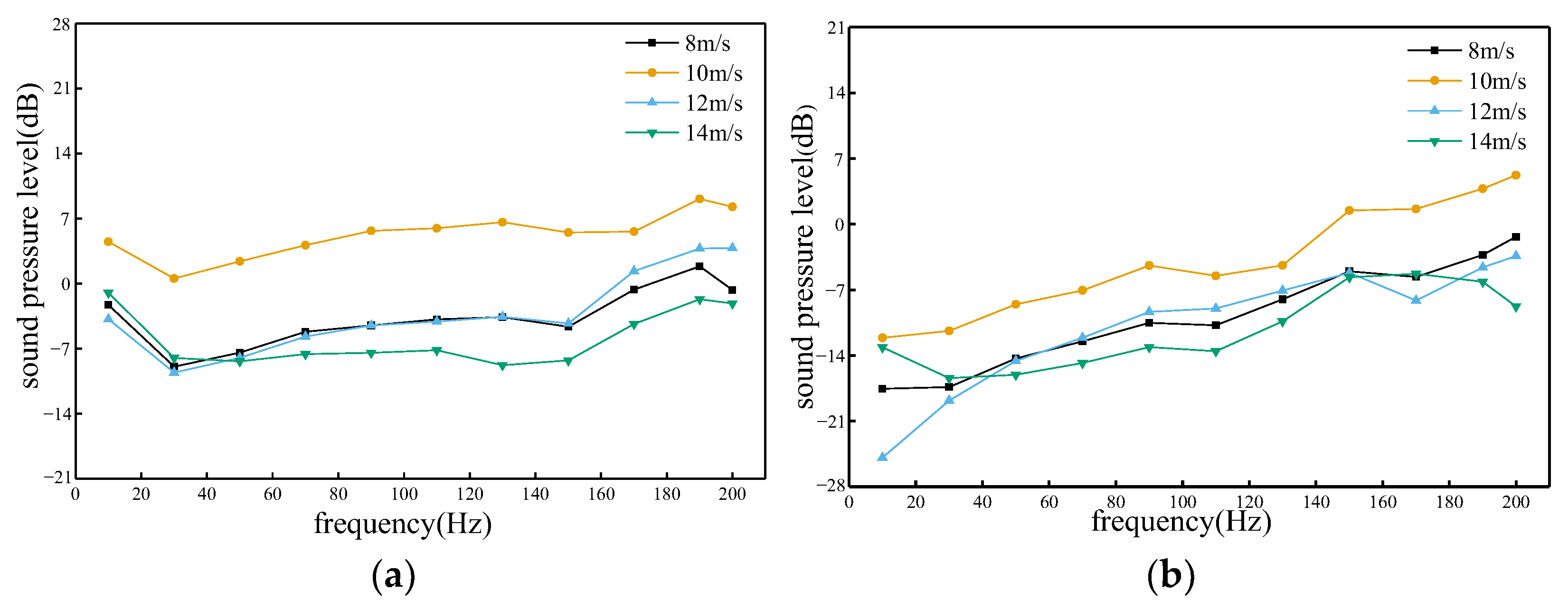
| Vehicle Speed (km/h) | Slip Angle (°) | Coupling Wind Speed (m/s) |
|---|---|---|
| Wind Direction Angle (°) | Slip Angle (°) | Coupling Wind Speed (m/s) |
|---|---|---|
| Wind Speed (m/s) | Slip Angle (°) | Coupling Wind Speed (m/s) |
|---|---|---|
Disclaimer/Publisher’s Note: The statements, opinions and data contained in all publications are solely those of the individual author(s) and contributor(s) and not of MDPI and/or the editor(s). MDPI and/or the editor(s) disclaim responsibility for any injury to people or property resulting from any ideas, methods, instructions or products referred to in the content. |
© 2023 by the authors. Licensee MDPI, Basel, Switzerland. This article is an open access article distributed under the terms and conditions of the Creative Commons Attribution (CC BY) license (https://creativecommons.org/licenses/by/4.0/).
Share and Cite
Zhao, X.; Zhang, L.; Li, L.; Feng, Q. Study on the Characteristics of Trackside Acoustic Flow Field of High-Speed Train under the Influence of Crosswind. Sensors 2023, 23, 8537. https://doi.org/10.3390/s23208537
Zhao X, Zhang L, Li L, Feng Q. Study on the Characteristics of Trackside Acoustic Flow Field of High-Speed Train under the Influence of Crosswind. Sensors. 2023; 23(20):8537. https://doi.org/10.3390/s23208537
Chicago/Turabian StyleZhao, Xing, Lei Zhang, Lin Li, and Qiying Feng. 2023. "Study on the Characteristics of Trackside Acoustic Flow Field of High-Speed Train under the Influence of Crosswind" Sensors 23, no. 20: 8537. https://doi.org/10.3390/s23208537
APA StyleZhao, X., Zhang, L., Li, L., & Feng, Q. (2023). Study on the Characteristics of Trackside Acoustic Flow Field of High-Speed Train under the Influence of Crosswind. Sensors, 23(20), 8537. https://doi.org/10.3390/s23208537






